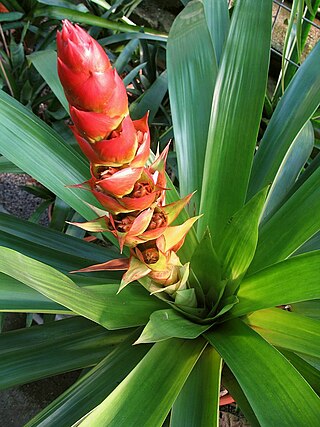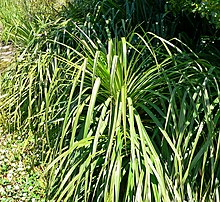
Dieffenbachia, commonly known as dumb caneorleopard lily, is a genus of tropical flowering plants in the family Araceae. It is native to the New World Tropics from Mexico and the West Indies south to Argentina. Some species are widely cultivated as ornamental plants, especially as houseplants, and have become naturalized on a few tropical islands.

Oncidium, abbreviated as Onc. in the horticultural trade, is a genus that contains about 330 species of orchids from the subtribe Oncidiinae of the orchid family (Orchidaceae). As presently conceived, it is distributed across much of South America, Central America, Mexico and the West Indies, with one species (O. ensatum) extending into Florida. Common names for plants in this genus include dancing-lady orchid and golden shower orchid.

Zamia is a genus of cycad of the family Zamiaceae, native to North America from the United States throughout the West Indies, Central America, and South America as far south as Bolivia. The genus is considered to be the most ecologically and morphologically diverse cycads, and is estimated to have originated about 68.3 million years ago.

Clethra is a genus of flowering shrubs or small trees described as a genus by Linnaeus in 1753.

Bromelia is a genus of about 70 plant species widespread across Latin America and the West Indies. It is the type genus of the family Bromeliaceae, subfamily Bromelioideae, and its type species is B. karatas. Bromelia species are characterized by flowers with a deeply cleft calyx. The genus is named after the Swedish medical doctor and botanist Olof Bromelius (1639-1705).

Vriesea is a genus of flowering plants in the botanical family Bromeliaceae, subfamily Tillandsioideae. The genus name is for Willem Hendrik de Vriese, Dutch botanist, physician (1806–1862). Its species are widespread over Mexico, Central America, South America and the West Indies.

Dracontium is a genus of flowering plants similar to those of Amorphophallus. Unlike Amorphophallus which is found in the Old World, this genus has a New World distribution and is native to South America, Central America, southern Mexico, and the West Indies.

Pitcairnia is a genus of plants in the family Bromeliaceae, subfamily Pitcairnioideae. It was named for William Pitcairn, Scottish physician and gardener (1711–1791). The genus Pitcairnia ranks as the second most prolific of the bromeliad family. They are most abundant in Colombia, Peru and Brazil, but can also be found in areas from Cuba and Mexico south to Argentina. One species, Pitcairnia feliciana, is found in tropical West Africa and is the only member of the family Bromeliaceae not native to the Americas.

Mezobromelia is a genus of the botanical family Bromeliaceae, subfamily Tillandsioideae. The genus name is for Carl Christian Mez, German botanist (1866-1944). Some authorities treat Mezobromelia as a synonym of Cipuropsis.

Ronnbergia is a genus in the plant family Bromeliaceae, subfamily Bromelioideae. Native to South and Central America, this genus was named for Auguste Ronnberg, Belgian Director of Agriculture and Horticulture in 1874.

Eschweilera is a genus of woody plants in the family Lecythidaceae first described as a genus in 1828. It is native to southern Mexico, Central America, South America, and Trinidad.

Aegiphila is a genus of flowering plants in the mint family, Lamiaceae, first described in 1763. It was formerly classified in the Verbenaceae. It is native to Mexico, Central America, South America, the West Indies, and Florida.

Gonolobus is a genus of plant in family Apocynaceae, first described in 1803. It is native to South America, Central America, Mexico, the West Indies, and the southern United States.

Citharexylum is a genus of flowering plants in the verbena family, Verbenaceae. It contains shrub and tree species commonly known as fiddlewoods or zitherwoods. They are native to the Americas, ranging from southern Florida and Texas in the United States to Argentina. The highest diversity occurs in Mexico and the Andes. The generic name is derived from the Greek words κιθάρα (kithara), meaning "lyre", and ξύλον (xylon), meaning "wood," referring to the use of the wood in the sounding boards of string instruments. Several species, especially C. caudatum and C. spinosum, are cultivated as ornamentals.
- Citharexylum affineD.Don - from northern Mexico to Nicaragua
- Citharexylum alainiiMoldenke - Dominican Republic
- Citharexylum albicauleTurcz. - Cuba
- Citharexylum altamiranumGreenm. - northeastern Mexico
- Citharexylum andinumMoldenke - Bolivia, Jujuy Province of Argentina
- Citharexylum argutedentatumMoldenke - Peru
- Citharexylum berlandieriB.L. Rob. - from Texas to Oaxaca - Berlandier's fiddlewood, Tamaulipan fiddlewood
- Citharexylum bourgeauanumGreenm. - Veracruz, Oaxaca
- Citharexylum brachyanthum(A.Gray ex Hemsl.) A.Gray - Texas, Coahuila, Nuevo León - Boxthorn fiddlewood, Mexican fiddlewood
- Citharexylum bullatumMoldenke - Colombia
- Citharexylum calvumMoldenke - Quintana Roo
- Citharexylum caudatumL. - southern Mexico, West Indies, Central America, Colombia, Peru - Juniper berry
- Citharexylum chartaceumMoldenke - Peru, Ecuador
- Citharexylum cooperiStandl. - Costa Rica, Panama, Guatemala
- Citharexylum costaricenseMoldenke - Costa Rica, Nicaragua, Honduras
- Citharexylum crassifoliumGreenm - Chiapas, Belize, Guatemala, Honduras
- Citharexylum daniraeLeón de la Luz & F.Chiang - Revillagigedo Islands of Baja California
- Citharexylum decorumMoldenke - Colombia, Venezuela
- Citharexylum dentatumD.Don - Peru
- Citharexylum discolorTurcz. - Cuba, Hispaniola
- Citharexylum donnell-smithiiGreenm. - Oaxaca, Chiapas, Central America
- Citharexylum dryanderaeMoldenke - Colombia, Venezuela, Peru, Ecuador
- Citharexylum ekmaniiMoldenke - Cuba
- Citharexylum ellipticumMoc. & Sessé ex D.Don - Veracruz, Campeche, Tabasco; naturalized in Cuba + Cayman Islands
- Citharexylum endlichiiMoldenke - northeastern Mexico
- Citharexylum flabellifoliumS.Watson - Sonora, Baja California
- Citharexylum flexuosum(Ruiz & Pav.) D.Don - Bolivia, Peru
- Citharexylum fulgidumMoldenke - Veracruz, northeastern Mexico
- Citharexylum gentryiMoldenke - Ecuador
- Citharexylum glabrum(S.Watson) Greenm - Oaxaca
- Citharexylum glazioviiMoldenke - eastern Brazil
- Citharexylum grandiflorumAymard & Rueda - Ecuador
- Citharexylum guatemalense(Moldenke) D.N.Gibson - Guatemala, Nicaragua
- Citharexylum herreraeMansf. - Peru
- Citharexylum hexangulareGreenm. - from northern Mexico to Costa Rica
- Citharexylum hidalgenseMoldenke - Mexico
- Citharexylum hintoniiMoldenke - México State
- Citharexylum hirtellumStandl. - from Veracruz to Panama
- Citharexylum ilicifoliumKunth - Bolivia, Peru, Ecuador
- Citharexylum iltisiiMoldenke - Peru
- Citharexylum × jamaicenseMoldenke - Jamaica, Haiti, Puerto Rico (C. caudatum × C. spinosum)
- Citharexylum joergensenii(Lillo) Moldenke - Argentina, Bolivia
- Citharexylum karsteniiMoldenke - Colombia, Venezuela
- Citharexylum kerberiGreenm. - Veracruz
- Citharexylum kobuskianumMoldenke - Peru
- Citharexylum krukoviiMoldenke - eastern Brazil
- Citharexylum kunthianumMoldenke - Colombia, Venezuela, Ecuador
- Citharexylum laetumHiern - southern Brazil
- Citharexylum laurifoliumHayek - Bolivia, Peru
- Citharexylum lemsiiMoldenke - Guanacaste Province in Costa Rica
- Citharexylum × leonisMoldenke - Cuba (C. caudatum × C. tristachyum)
- Citharexylum ligustrifolium(Thur. ex Decne.) Van Houtte - Mexico
- Citharexylum lojenseMoldenke - Ecuador
- Citharexylum lucidumCham. & Schltdl. - Mexico
- Citharexylum lycioidesD.Don - Mexico
- Citharexylum macradeniumGreenm. - Panama, Costa Rica
- Citharexylum macrochlamysPittier - Panama, Colombia
- Citharexylum macrophyllumPoir. - Colombia, Venezuela, Ecuador, Guianas, northwestern Brazil
- Citharexylum matheanumBorhidi & Kereszty - Cuba
- Citharexylum matudaeMoldenke - Chiapas
- Citharexylum mexicanumMoldenke - Veracruz, Puebla, Oaxaca
- Citharexylum microphyllum(DC.) O.E.Schulz - Hisipaniola
- Citharexylum mirifoliumMoldenke - Colombia, Venezuela
- Citharexylum mocinoiD.Don - Mexico, Central America
- Citharexylum montanumMoldenke - Colombia, Ecuador
- Citharexylum montevidense(Spreng.) Moldenke - Brazil, Argentina, Paraguay, Uruguay
- Citharexylum myrianthumCham. - Brazil, Argentina, Paraguay
- Citharexylum obtusifoliumKuhlm - Espírito Santo
- Citharexylum oleinum Moldenke - Mexico
- Citharexylum ovatifoliumGreenm. - Mexico
- Citharexylum pachyphyllumMoldenke - Peru
- Citharexylum pernambucenseMoldenke - eastern Brazil
- Citharexylum poeppigiiWalp. - Colombia, Venezuela, Ecuador, Bolivia, Peru, Brazil
- Citharexylum punctatumGreenm. - Bolivia, Peru
- Citharexylum quercifoliumHayek - Peru
- Citharexylum quitenseSpreng. - Ecuador
- Citharexylum racemosumSessé & Moc. - Mexico
- Citharexylum reticulatumKunth - Ecuador, Peru
- Citharexylum rigidum(Briq.) Moldenke - Paraguay, southern Brazil
- Citharexylum rimbachiiMoldenke - Ecuador
- Citharexylum roseiGreenm. - Mexico
- Citharexylum roxanaeMoldenke - Baja California
- Citharexylum scabrumMoc. & Sessé ex D.Don - northern Mexico
- Citharexylum schottiiGreenm. - southern Mexico, Central America
- Citharexylum schulziiUrb. & Ekman - Hispaniola
- Citharexylum sessaeiD.Don - Mexico
- Citharexylum shreveiMoldenke - Sonora
- Citharexylum solanaceumCham. - southern Brazil
- Citharexylum spinosumL. – Spiny fiddlewood - West Indies, Panama, Venezuela, the Guianas; naturalized in India, Mozambique, Fiji, Bermuda
- Citharexylum stenophyllumUrb. & Ekman - Haiti
- Citharexylum steyermarkiiMoldenke - Veracruz, Chiapas, Guatemala
- Citharexylum suberosumLoes. ex Moldenke - Cuba
- Citharexylum subflavescensS.F.Blake - Colombia, Venezuela, Ecuador, Peru
- Citharexylum subthyrsoideumPittier - Colombia, Venezuela
- Citharexylum subtruncatumMoldenke - northwestern Brazil
- Citharexylum sulcatumMoldenke - Colombia
- Citharexylum svensoniiMoldenke - Ecuador
- Citharexylum teclenseStandl. - El Salvador
- Citharexylum ternatumMoldenke - Cuba
- Citharexylum tetramerumBrandegee - Valle de Tehuacán-Cuicatlán in Mexico
- Citharexylum tristachyumTurcz. – Threespike Fiddlewood - Cuba, Jamaica, Leeward Islands
- Citharexylum uleiMoldenke - Colombia, Peru, northwestern Brazil
- Citharexylum vallenseMoldenke - Colombia
- Citharexylum venezuelenseMoldenke - Venezuela
- Citharexylum weberbaueriHayek - Peru

Smallanthus is a genus of flowering plants in the tribe Millerieae within the family Asteraceae.

Sarcoglottis is a genus of flowering plants from the orchid family, Orchidaceae. It is widespread across much of Latin America from Mexico to Argentina, with one species extending northward into Trinidad and the Windward Islands.
Tillandsia chontalensis, synonym Vriesea chontalensis, is a species of flowering plant in the family Bromeliaceae, native from Central America to Colombia, north west Ecuador and west Bolivia. It was first described by John Gilbert Baker in 1887.

Chomelia is a genus of flowering plants in the family Rubiaceae. It is native to Mexico, Central America, the West Indies, and much of South America as far south as Argentina.
This article details the matches played by the Venezuela national football team from 2000 to 2019.

















